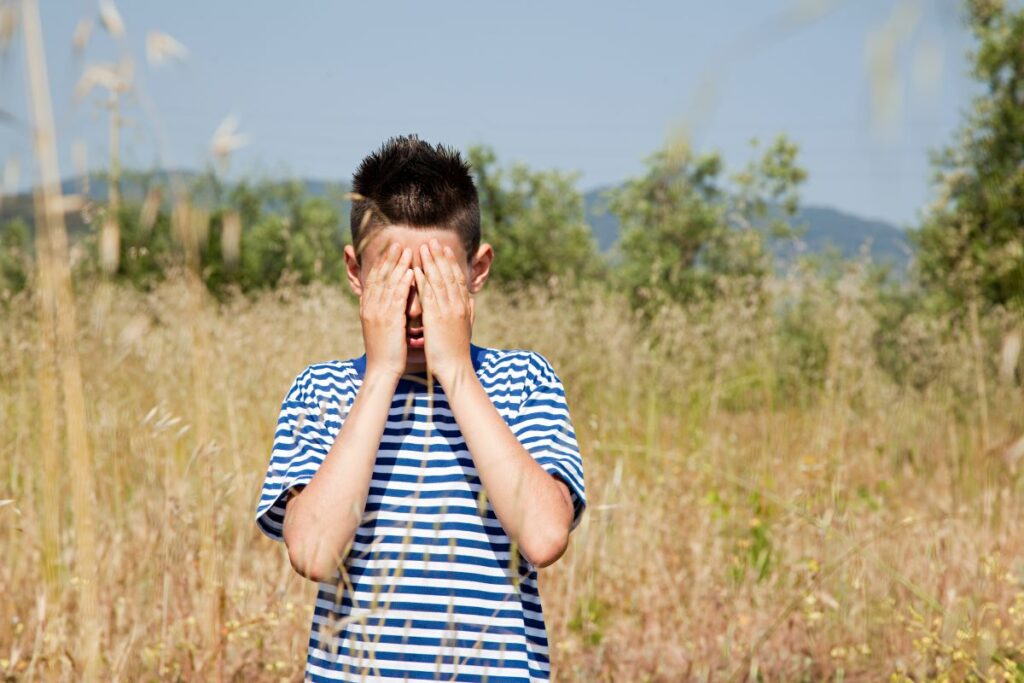Apiphobia, the fear of bees, is a specific phobia that is characterized by an excessive and irrational fear of bees and bee stings.
While some individuals may experience mild discomfort around bees, those with apiphobia can suffer intense anxiety, leading to avoidance behaviors that can impact their daily lives.
The fear often emerges from a negative experience, such as a painful bee sting or observing others react fearfully to bees.
Understanding Apiphobia

Apiphobia, or melissophobia, falls within the broader category of animal phobias and is one of the more common specific phobias. This is classified as a specific phobia concerning bees.
Unlike a rational fear of bees, which might be based on the potential for a bee sting, apiphobia involves an excessive fear response that extends beyond actual encounters with bees. This type of phobia can be instigated by images, videos, or even the mere mention of bees.
Some studies suggest that apiphobia may develop from a negative bee-related experience during childhood or from traumatic events encountered through media such as movies or published articles. This fear is not necessarily from firsthand experiences but can be learned behavior.
Individuals with an allergy to bee venom may develop apiphobia due to the potentially life-threatening nature of anaphylaxis. In such cases, the fear of being stung by a bee holds a significant basis, as it relates to a genuine medical concern.
Symptoms
Symptoms can be both psychological and physical and may include:
- Sweating
- Nausea
- Trembling
- Shortness of breath
- Dizziness
- Overwhelming anxiety
- Panic attacks
- Increased heart rate
These reactions are disproportionate to the actual threat posed by bees and can severely impact a person’s daily life.
Causes

Apiphobia, or the fear of bees, is often a consequence of both psychological and environmental factors.
Learned behavior plays a significant role; individuals may develop this fear after observing others react adversely to bees. For instance, a parent’s anxious response to bees can inadvertently condition a child to perceive bees as threatening.
Childhood experiences are also pivotal. A single negative encounter such as a painful bee sting during formative years can leave a lasting impression, embedding a strong fear response associated with bees.
Media portrayals can further amplify this condition. For example, films or videos that depict bees as dangerous can reinforce and spread apprehension. In some cases, even without direct experience, sensationalized or dramatic media content alone can instigate a deep-rooted fear in individuals.
An individual’s personal beliefs, often influenced by cultural and educational background, additionally contribute to the emergence of apiphobia. Misinformation or lack of knowledge about the ecological significance of bees can skew perceptions, leading to an irrational fear rather than a healthy respect for these insects.
Comprehensive studies generally acknowledge a combination of these factors as potential catalysts for the development of apiphobia. They suggest that both direct and vicarious experiences play collective roles in this phobia’s genesis.
Diagnosis
In addressing apiphobia, it is imperative to follow a structured approach that includes a precise clinical diagnosis.
Clinical diagnosis of apiphobia begins with a thorough assessment by a mental health professional according to the criteria outlined in the Diagnostic and Statistical Manual of Mental Disorders (DSM-5) for specific phobias described in code 300.29. Criteria include:
- The person experiences excessive or unreasonable, persistent, and intense fear triggered by a specific object or situation.
- The fear reaction is out of proportion to the actual danger and appears almost instantaneously when presented with the object or situation.
- The individual goes out of their way to avoid the fear trigger or endures it with extreme distress.
- The phobia significantly impacts the person’s school, work, or personal life.
The diagnostic process often includes discussions of the individual’s history with anxiety and panic incidents related to the phobic stimulus.
Treatment

Apiphobia, the fear of bees, is a specific phobia that can be effectively managed with targeted therapeutic approaches.
Cognitive Behavioral Therapy (CBT)
Cognitive Behavioral Therapy is a widely recognized treatment for apiphobia, focusing on altering the thought patterns that contribute to the phobia.
The process involves identifying irrational beliefs about bees and restructuring them to reduce fear and anxiety.
Exposure Therapy
Exposure Therapy is considered a first-line treatment for specific phobias like apiphobia. Treatment involves gradual exposure to bee-related stimuli, where patients are slowly desensitized to their fear in a controlled and safe environment.
Virtual Reality Exposure Therapy
Virtual Reality Exposure Therapy provides an innovative way to treat apiphobia using simulated environments.
This allows individuals to face their fears of bees in a virtual space, which can be an effective step before real-life exposure or in situations where actual exposure is impractical.
Living with Apiphobia
Living with apiphobia, the irrational fear of bees poses substantial challenges and impacts daily life.
Effective management involves specific coping strategies, supporting, and progressing toward long-term recovery.
Coping Strategies

Relaxation techniques such as taking deep breaths and mindfulness practices can help manage symptoms of panic on the spot.
Consultation with a trained therapist may lead them to use graduated exposure therapy, which is supported by peer-reviewed studies.
Carrying bee repellent and knowing local bee removal services provide a tangible sense of control.
Support
Support and management are key components in the long-term treatment of apiphobia. Joining a support group may provide comfort and coping strategies through shared experiences.
While in-person support groups specifically tailored to apiphobia may be limited, online support groups can offer valuable resources, understanding, and community for individuals dealing with this fear.
Online support groups for apiphobia can be found on various platforms, including platforms like Facebook or Reddit.
Additionally, friends and family can help by facilitating a supportive environment, such as choosing indoor activities or providing a safe space where the individual knows there will not be bees.
Progressing Toward Recovery
Long-term recovery may incorporate progressive strategies like a fear ladder, which ranks situations by the level of fear they induce, and tackles them systematically.
Treatment strategies such as cognitive behavioral therapy (CBT) focus on altering the thought patterns contributing to the phobia and are proven to be effective.
Raising awareness about the unlikelihood of aggressive encounters, such as those with “killer bees,” can also reduce fear.
Participation in therapeutic programs must be consistent and often requires the support of a beekeeper or mental health professional experienced in treating anxiety disorders.
How to Find a Therapist to Address Apiphobia?
To address apiphobia is crucial to look for mental health professionals who specialize in treating phobias.
You can search online directories such as Find-a-therapist.com where you can find therapists who specialize in anxiety disorders or specific phobias.
Additionally, you can use BetterHelp, one of the world’s largest online therapy services, which matches you with the right therapist according to your specific needs.
Frequently Asked Questions

What are the typical symptoms associated with the fear of bees?
Individuals with apiphobia may experience symptoms such as intense anxiety, uncontrollable panic, a racing heartbeat, or shortness of breath when they encounter or think about bees.
How can one differentiate between apiphobia and melissophobia?
Apiphobia is specifically the fear of bees, while melissophobia can refer to the broader fear of bees or bee stings, encompassing a wider range of bee-related anxieties.
How common is the fear of bees and wasps among the general population?
The fear of bees and wasps, such as apiphobia and spheksophobia, is a relatively common form of specific phobia.
According to the National Institute of Mental Health (NIMH), an estimated 9.1% of American adults experience a specific phobia, with a higher prevalence among females. While this category encompasses apiphobia, the fear of bees, the exact prevalence of apiphobia itself is not well-documented.
What are the main categories of phobias which include fears like apiphobia?
Phobias such as apiphobia fall into the category of specific phobias, which are characterized by a marked and persistent fear of a particular object or situation.
In terms of treatment, how is a fear of bees or wasps typically addressed?
Treatment for apiphobia often involves cognitive-behavioral therapy (CBT), which may include exposure therapy to gradually reduce the individual’s fear response to bees or wasps.
References
Ashbaugh, A. R. (2015). Anxiety and Related Disorders Interview Schedule. Phobias: The Psychology of Irrational Fear: The Psychology of Irrational Fear, 23. Link.
Choy, Y., Fyer, A. J., & Lipsitz, J. D. (2007). Treatment of specific phobia in adults. Clinical psychology review, 27(3), 266-286. Link.
Schönfelder, M. L., & Bogner, F. X. (2017). Individual perception of bees: Between perceived danger and willingness to protect. PLoS One, 12(6), e0180168. Link.





